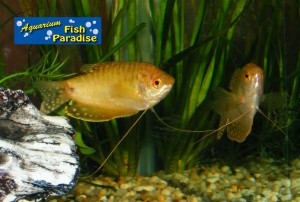
PRICE GUIDE
5cm: $8-$12
7cm: $12-$18Golden Gourami
One of the most enjoyable community fish available today is the Golden Gourami. Their good looks and unique behaviour makes them the ideal fish for a larger tropical freshwater community tank. Golden Gourami’s are relatively large fish, growing to a maximum of 12cm. It has a beautiful bright orange colour and features long thin pelvic fins that are effectively used as feelers.
Common Name(s) : Golden Gourami
Family : Osphronemidae
Genus: Trichopodus
Species : Trichogaster trichopterus
Origin : Asia – Malaysia, Thailand, Burma, Vietnam
PH : 6.5 – 7.5
Hardness : Soft to Hard
Temperature : 23 – 28°C / 73–82°F
Maximum Size : 12cm / 4.8″
Lifespan : 5-6 years
Aggression Level : Medium-Low (4/10)
Recommended Tank Size : 65 Litres +
Recommended Tank Setup: Planted, Areas of subdued light, dark gravel for best effect
Strata : Middle – Top Half
TANK SET UP
Prefer a heavily planted tank. Add some driftwood plants to help create their natural environment.
Provide areas of subdued light in the aquarium to make them most comfortable
SUITABLE TANK MATES
- Most Large / Medium Tropical Fish
- Dwarf Cichlids
- Guppies
- Tetras
DIET
Omnivores, in the wild they eat insect larvae, crustaceans, zooplankton and plants. In the aquarium they will accept a wide range of foods including flake, small pellets, bloodworms and brine shrimp.
SEXING AND BREEDING
Female’s grow larger than males. A Gourami’s sex can be identified by the shape of the dorsal fin, which is long and pointed in males, compared to the female’s shorter rounded dorsal. b
To breed them, condition a male and a female on some frozen food like bloodworm or brine shrimp for several weeks, when the female is gravid (fat with eggs) remove her from the community tank and move her into another tank with little or no filtration (you need very little water flow at the top of the water) and some plants – even add a cave or ornament for the possibility a scared female can retreat once the deed is done. Ensure the new tank has a lid – bubble nests require warm air for eggs to do well.
After a few days, add the male to the same tank. The male will begin to build a bubble nest on top of the water. Once he has finished he will seek her attention as they will ‘dance” together before he squeezes the eggs from the female. He fertilizes the eggs, he will then place the eggs into the bubble nest.
At this time you must carefully remove the female (being sure not to disturb the bubble nest) from the aquarium because she will be niaive and will eat the eggs (which ensures he will attack and maybe kill her for..) and leave the male in there (as he does all the caring for the eggs) for the next 24 hours – at which time the eggs will hatch.
Of the the 600-800 eggs, only a handful of fry will survive, they can be raised on baby brine shrimp until old enough to take flake food or other frozen foods.
OTHER USEFUL INFORMATION
The Golden Gourami’s can be comical in antics amongst themselves in the aquarium and is nothing short of entertaining. They will chase one another around the tank, particularly after a feeding, that will consume you as you chuckle at their behavior while you wonder what will happen next. Generally this behavior signifies that they are not playing, but rather disputing territory.
Golden Gourami’s possess a labryinth organ, which allows them to breath air directly from the surface as well as under the water. You will notice them constantly visiting the water’s surface to grab a gulp of air. In the wild, this allows them to live in swamps or pools of low water quality.
Golden Gourami’s are omnivores and will eat a variety of foods including flake food, live or frozen brine shrimp, algae flakes, bloodworms, plants and green vegetables.
Golden Gourami’s are found in Malaysia, Thailand, Burma and Vietnam in southeast Asia where their natural habitat is heavily vegetated slow moving streams under subdued lighting of the jungle canopy. Golden Gourami’s upturned mouths make them excellent predators of small worms and crustaceans that they located near the waters surface.
Ideally Goldenl Gourami’s should be housed in aquariums that replicate their natural habitat – plenty of vegetation, low to moderate water movement and areas of subdued lighting. Darker substrates are ideal as they more closely mimic the peat covered river bottoms of their native rivers. Darker substrates and heavy vegetation will also bring out the brilliant gold coloration of the Gourami.
Golden Gourami’s possess a labryinth organ, which allows them to breath air directly from the surface as well as under the water. You will notice them constantly visiting the water’s surface to grab a gulp of air. In the wild, this allows them to live in swamps or pools of low water quality.
Golden Gourami are considered an easy species to keep in the home aquarium as they are both easy to feed and tolerant of a variety of water conditions and they will generally habitat the mid to top level of the aquarium.

Leave a Reply
You must be logged in to post a comment.